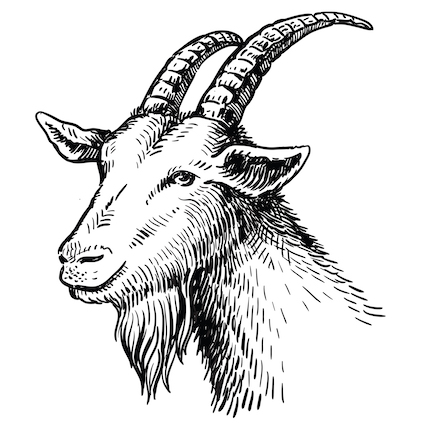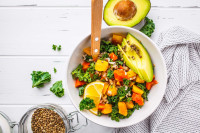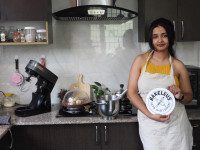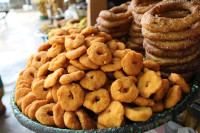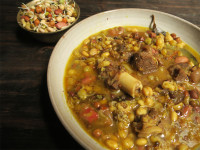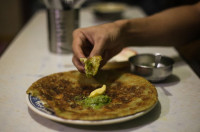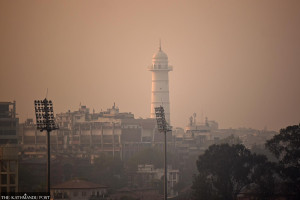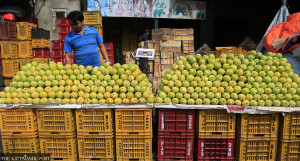Food
What’s black and tastes like goat? Kalo Masu, obviously.
It’s a simple idea really: stirring diced goat in a giant pot for hours until it blackens—hence called Kalo Masu—and then mixed with about a dozen spices and a whole lot of ghee.
Goat
By the time the kebab travelled across the Middle East and arrived in the hills of Nepal, it had lost the skewers and hot coal, and become kawaf. Today, to most Nepalis, kawaf is what you do to goat meat during Dashain, the annual holiday that shuts down the country for the sole purposes of feasting.
But goat kawaf, also widely known as pakku, is a more elaborate dish than the popular kebab. It’s a simple idea really: stirring diced goat in a giant pot for hours until it blackens—hence called Kalo Masu—and then mixed with about a dozen spices and a whole lot of ghee.
In fact, in a country where most of the popular meat dishes revolve around the same recipe—onion, tomatoes, ginger, garlic, water, simmer, done—and the monotonous light brown curry, Kalo Masu stands out. Succulent pieces of goat meat, preferably from the leg of a young goat, smothered judiciously with dry spices and cooked until it’s black, moist and perfect.
For connoisseurs, the most rewarding feeling from Kalo Masu won’t be immediate—it would be a couple of days after the cooking is done, as you pull a tub of leftover kawaf out of the fridge, separate the pieces covered with a layer of fat and ghee, heat it in a shallow pan, and go at it.
[Read: This is not your father's (or mother's) goat curry]
Ingredients
1½ kg goat leg, cut into 3-4cm pieces
2 tbsp mustard oil
2 tsp salt
3 medium cloves garlic, smashed, then coarsely chopped
5 1/2 tbsp ghiu, or more as needed
4-5 whole cloves
4 green cardamom pods
1 pinch fenugreek seeds (about 10 seeds)
2 large dried red chili peppers, broken into halves
2 tsp ground turmeric
2 tsp ground cumin
2 tsp ground coriander
1 tsp asafetida
1 tsp chili powder or flakes
¼ cup cilantro leaves, for garnish
Instructions
Place the goat meat in a zip-top bag or a big steel bowl. Add the mustard oil, salt and half of the garlic. Get your hands in there and massage to coat the meat evenly. Let sit for about an hour at room temperature, or refrigerate up to eight hours.
Heat the ghiu in a large kasaudi over medium heat. If cooking meat from a whole goat, as one would do at this time of year, and during other feasts, experiment cooking in a taulo, a giant copper pot.
Meanwhile, use a mortar and pestle to crush the cloves and cardamom. Once the ghiu has melted and heated through, add fenugreek seeds, dried chili peppers, and crushed cloves and cardamom; cook for about five minutes, until the spices are fragrant and fenugreek seeds have turned dark brown.
Stir in the marinated goat meat (with its oil, garlic and spices) until it’s evenly coated with all the ingredients in the pot. Cook, uncovered, for 45 minutes, stirring occasionally, so all pieces of meat get a chance to brown at the bottom of the pot. The meat will darken and appear to lose its moisture.
Stir in the turmeric, cumin, coriander, asafetida, chilli powder and the remaining garlic. Cover and cook for 15 minutes, stirring occasionally until the spices have been evenly distributed. If the bottom of the pot looks dry, stir in an extra tablespoon of ghiu, then cover, reduce the heat to medium-low and cook for 15 to 20 minutes, until the meat has darkened further and become tender.
Transfer to a warmed serving bowl or platter. Garnish with cilantro and serve with rice, beaten rice, or puffed rice. Or eat it by itself. No one will judge you.
The cooked dish can be refrigerated for several days and can be reheated in a shallow pan, covered and without water for about 15 minutes.
See other recipes:
- How to make fried liver
- Kabargah: Goat ribs, cooked in milk and ghee
- How to roast a leg of goat (or lamb)
- This is not your father’s (or mother’s) goat curry




 27.07°C Kathmandu
27.07°C Kathmandu